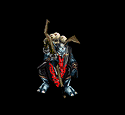My Hero Academia, Chapter 154: An Unseen Hope
Woo, this chapter. It's another action-oriented chapter, but one that also has a fair bit of talk about it. First up, I do feel that the sudden talk about how Aizawa's missing and apparently transported elsewhere by Chisaki's powers or some shit kind of came out of nowhere. It has been some time since I read chapter 153 (two weeks, I believe) but I certainly don't remember a scene where Aizawa was removed from the equation. That was a bit of a rough patch.
 We also get the confirmation from Chisaki that Mirio's powers have been erased permanently -- or at least, he claims it to be. That's going to be a hard-hitting blow for Mirio, considering how much he's worked to become a hero with his powers and all that. We've had one of the Pussycats get her power stolen by All For One's forces, but she wasn't an actual proper character like Mirio is.
We also get the confirmation from Chisaki that Mirio's powers have been erased permanently -- or at least, he claims it to be. That's going to be a hard-hitting blow for Mirio, considering how much he's worked to become a hero with his powers and all that. We've had one of the Pussycats get her power stolen by All For One's forces, but she wasn't an actual proper character like Mirio is.
Mirio himself doesn't really get that much of a chance to react, considering his main priorities in this fight is getting Eri the fuck hell out of the place. Eri's still crying and stuff.
Most of the fight takes place between Midoriya, Nighteye and Chisaki, and the artwork is pretty dang gorgeous. We get some pretty cool fight scenes with Chisaki's abomination form, and Midoriya swinging around rock spikes and shit.
We also get a bit of a flashback to Nighteye's Foresight power, and how apparently the act of seeing the future seems to 'lock' that future in place. Nighteye's narration in the flashback says about how seeing the future doesn't really allow him to change the future, and uses a movie as an example -- it'd be like inserting a couple of extra scenes in between now and the future, but the ending will still be the same nonetheless. Nighteye apparently saw into Chisaki's future, seeing his defeat, but sees also the sliver of hope that Midoriya, Mirio and Eri manage to escape. And he gets stabbed through the gut with a rock spike.
Midoriya then goes berserk, activating One For All up to 20%, and just stamps on the ground to block Chisaki's rock spikes and roars about how he's going to bend the future or something. It's a pretty interesting theme that they chose to tackle in this chapter -- predestination tends to be a crap shoot of a topic to explore in a manga. Either the future's going to be bent by nothing more than sheer determination, which feels cheap, or you can't change the future and it's set in stone, which would be depressing. So I'm definitely interested to see where Boku no Hero Academia plans to take this. Good stuff.

























































